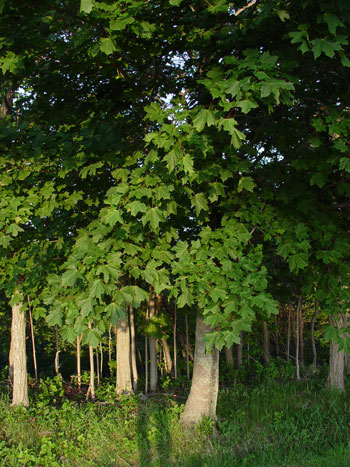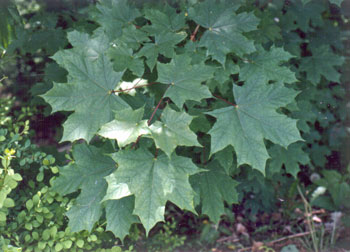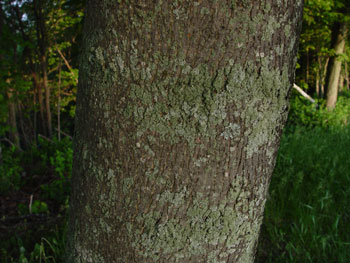DACF Home → Bureaus & Programs → Maine Natural Areas Program → Communities, Plants, and Animals → Invasive Plants → Norway Maple
 Norway maple trees
Norway maple trees
Norway Maple
Acer platanoides
2019 Status in Maine: Widespread. Very Invasive.
Description: Extremely shade-tolerant, canopy-height tree, often planted. Cultivars include "Crimson King" which has purple-red color. Leaves: Opposite, 5-lobed with pointed tips but without other teeth. Broken petiole oozes white sap – distinguishes this species from native maples. Winter buds are reddish-green and rounded. Flowers: Tiny, yellow-green, high in canopy, early spring. Fruit: Typical maple samara but with a very wide angle. Bark: Furrowed, dark gray, not shaggy like native maples.
Native range: Europe, Eastern Asia. How arrived in U.S.: As an ornamental and shade tree.
Reproduction: By seeds which are dispersed short distances by wind or small mammals; occasional long-distance transport by water might be possible.
Habitat: Forests, forest edges, open areas. Extremely shade-tolerant, can germinate and compete under a closed canopy.
Similar native species: Norway maple could be mistaken for sugar maple (A. saccharum), but Norway maple has milky petiole sap, furrowed bark, and reddish-green, rounded buds, whereas sugar maple lacks milky sap, has shaggy bark, and has brown, pointed buds.
Similar non-native species: Amur maple (Acer ginnala) is a small tree, has much smaller, narrower leaf shape, and has toothed leaves.
Documented Ecological Impacts
- Norway maple inibits sapling growth of native forest species. (Galbraith-Kent, S.L. and S.N. Handel. 2008. Invasive Acer platanoides inhibits native sapling growth in forest understorey communities. Journal of Ecology 96:293-302)
- Norway maple out performs sugar maple and other native species regeneration, under itself and under sugar maple, partly because of its high shade tolerance and abundant seed crops. (Martin, P.H. 1999. Norway maple (Acer platanoides) invasion of a natural forest stand: understory consequence and regeneration pattern. Biological Invasions 1:215-222)
- Insect herbivory and fungal damage is less on Norway maple than native sugar maple, consistent with the enemy release hypothesis which states that invasive species are often more successful in their new range because they lack the enemies of their native range. (Cincotta et al. 2007. Testing the enemy release hypothesis: a comparison of foliar insect herbivory of the exotic Norway maple (Acer platanoides L.) and the native sugar maple (A. saccharum L.). Biological Invasions 11:379-388)
Fact Sheets and Identification Links
- SUNY-ESF, New York, (2:30)
- Vermont Invasives Factsheet for Norway Maple
- Go Botany page for Acer platanoides
 Norway maple leaves
Norway maple leaves
Control Methods
Seedlings can be pulled up*; saplings can be pulled with a weed lever or cut, but re-sprouting will occur so follow-up will be necessary. Longevity of seeds is not known. Larger trees can be cut, but will also re-sprout unless the cut stump is immediately treated with concentrated herbicide† (glyphosate or triclopyr). However, this is not effective in early spring due to sap rising. Repeated follow-up cutting can control re-sprouting from cut stumps, but persistence is required, sometimes for many years. Foliar spray can also be effective for seedlings, short saplings, or re-sprouts (glyphosate or triclopyr), as long as you can reach the top of the plant. For stems up to about 4-6" diameter, the basal bark treatment can be effective any time of year(spray lower 18-24" of trunk with triclopyr with penetrating oil). In urban or suburban areas where trees provide valuable shade, a phase-out approach (removing trees gradally over time) with re-planting of native tree species may be advisable.
* Correctly dispose of all plant parts↵ † Follow all label directions when using herbicides↵Control Technique Video Demonstrations
- No appropriate control videos found
 Norway maple bark
Norway maple bark
Please email invasives.mnap@maine.gov if you have questions about invasive species in Maine